Bên cạnh PHÂN TÍCH ĐỀ THI 30/5/2020"Some education systems make students focus on certain subjects at the age of 15, while others require students to study a wide range of subjects until they leave school. What are the benefits of each system? Which is better?"IELTS WRITING TASK 2 (kèm bài sửa HS đạt 6.5), IELTS TUTOR cũng cung cấp Adapting to the effects of climate change: Đề thi IELTS READING (IELTS Reading Practice Test)- Làm bài online format computer-based, kèm đáp án, dịch & giải thích từ vựng - cấu trúc ngữ pháp khó
I. Kiến thức liên quan
II. Làm bài online Adapting to the effects of climate change (kéo xuống cuối bài blog để xem giải thích từ vựng & cấu trúc cụ thể hơn)
📩 MN AI CHƯA CÓ ĐÁP ÁN FORECAST QUÝ MỚI PART 1-2-3 NHẮN ZL 0905834420 IELTS TUTOR GỬI FREE HẾT NHA
III. Adapting to the effects of climate change: Đề thi IELTS READING (IELTS Reading Practice Test)- Làm bài online format computer-based, kèm đáp án, dịch & giải thích từ vựng - cấu trúc ngữ pháp khó
Adapting to the effects of climate change
A
All around the world, nations are already preparing for, and adapting to, climate change and its impacts. Even if we stopped all CO2 emissions tomorrow, we would continue to see the impact of the CO2 already released since industrial times, with scientists forecasting that global warming would continue for around 40 years. In the meantime, ice caps would continue to melt and sea levels rise. Some countries and regions will suffer more extreme impacts from these changes than others. It’s in these places that innovation is thriving.
B
In Miami Beach, Florida, USA, seawater isn’t just breaching the island city’s walls, it’s seeping up through the ground, so the only way to save the city is to lift it up above sea level. Starting in the lowest and most vulnerable neighbourhoods, roads have been raised by as much as 61 centimetres. The elevation work was carried out as part of Miami Beach’s ambitious but much-needed stormwater-management programme. In addition to the road adaptations, the city has set up new pumps that can remove up to 75,000 litres of water per minute. In the face of floods, climate-mitigation strategies have often been overlooked, says Yanira Pineda, a senior sustainability coordinator. She knows that they’re essential and that the job is far from over. ‘We know that in 20, 30, 40 years, we’ll need to go back in there and adjust to the changing environment,’ she says.
C
Seawalls are a staple strategy for many coastal communities, but on the soft, muddy northern shores of Java, Indonesia, they frequently collapse, further exacerbating coastal erosion. There have been many attempts to restore the island’s coastal mangroves: ecosystems of trees and shrubs that help defend coastal areas by trapping sediment in their net-like root systems, elevating the sea bed and dampening the energy of waves and tidal currents. But Susanna Tol of the not-for-profit organisation Wetlands International says that, while hugely popular, the majority of mangrove-planting projects fail. So, Wetlands International started out with a different approach, building semi-permeable dams, made from bamboo poles and brushwood, to mimic the role of mangrove roots and create favourable conditions for mangroves to grow back naturally. The programme has seen moderate success, mainly in areas with less subsidence. ‘Unfortunately, traditional infrastructure is often single-solution focused,’ says Tol. ‘For long-term success, it’s critical that we transition towards multifunctional approaches that embed natural processes and that engage and benefit communities and local decision-makers.’
D
As the floodwaters rose in the rice fields of the Mekong Delta in September 2018, four small houses rose with them. Homes in this part of Vietnam are traditionally built on stilts but these ones had been built to float. The modifications were made by the Buoyant Foundation Project, a not-for-profit organisation that has been researching and retrofitting amphibious houses since 2006. ‘When I started this,’ explains founder Elizabeth English, ‘climate change was not on the tip of everybody’s tongue, but this technology is becoming necessary in places that didn’t previously need it.’ It’s much cheaper than permanently elevating houses, English explains – about a third of what it would cost to completely replace a building’s foundations. It also avoids the problem of taller houses being at greater risk from wind damage. Another plus comes from the fact that amphibious structures can be sensitively adapted to meet cultural needs and match the kind of houses that are already common in a community.
E
Bangladesh is especially vulnerable to climate change. Most of the country is less than a metre above sea level and 80 per cent of its land lies on floodplains. ‘Almost 35 million people living on the coastal belt of Bangladesh are currently affected by soil and water salinity,’ says Raisa Chowdhury of the international development organisation ICCO Cooperation. Rather than fighting against it, one project is helping communities adapt to salt-affected soils. ICCO Cooperation has been working with 10,000 farmers in Bangladesh to start cultivating naturally salt-tolerant crops in the region. Certain varieties of carrot, potato, kohlrabi, cabbage and beetroot have been found to be better suited to salty soil than the rice and wheat that is typically grown there. Chowdhury says that the results are very visible, comparing a barren plot of land to the ‘beautiful, lush green vegetable garden’ sitting beside it, in which he and his team have been working with the farmers. Since the project began, farmers trained in saline agriculture have reported increases of two to three more harvests per year.
F
Greg Spotts from Los Angeles (LA) in the USA is chief sustainability officer of the city’s street services department. He leads the Cool Streets LA programme, a series of pilot projects, which include the planting of trees and the installation of a ‘cool pavement’ system, designed to help reach the city’s goal of bringing down its average temperature by 1.5°C. ‘Urban cooling is literally a matter of life and death for our future in LA,’ says Spotts. Using a Geographic Information System data mapping tool, the programme identified streets with low tree canopy cover in three of the city’s neighbourhoods and covered them with a light-grey, light-reflecting coating, which had already been shown to lower road surface temperature in Los Angeles by 6°C. Spotts says one of these streets, in the Winnetka neighbourhood of San Fernando Valley, can now be seen as a pale crescent, the only cool spot on an otherwise red thermal image, from the International Space Station. >> IELTS TUTOR lưu ý: Bài sửa đề thi 22/8"Many companies nowadays sponsor sport as a way of advertising themselves. Some people think that it is good for the world of sport. Others say there are disadvantages. Discuss both view and give opinion"HS đi thi đạt 7.0 IELTS WRITING
Questions 14–17
Reading Passage has SIX paragraphs, A–F.
Which paragraph contains the following information?
14. how a type of plant functions as a natural protection for coastlines....................
15. a prediction about how long it could take to stop noticing the effects of climate change....................
16. a reference to the fact that a solution is particularly cost-effective....................
17. a mention of a technology used to locate areas most in need of intervention....................
Questions 18–22
Complete the sentences below.
Choose ONE WORD ONLY from the passage for each answer.
- The stormwater-management programme in Miami Beach has involved the installation of efficient 18....................
- The construction of 19.................... was the first stage of a project to ensure the success of mangroves in Indonesia.
- As a response to rising floodwaters in the Mekong Delta, a not-for-profit organisation has been building houses that can 20....................
- Rising sea levels in Bangladesh have made it necessary to introduce various 21.................... that are suitable for areas of high salt content.
- A project in LA has increased the number of 22.................... on the city’s streets. >> IELTS TUTOR lưu ý: PHÂN TÍCH ĐỀ THI TASK 1 VIẾT THƯ NGÀY 05/7/2020"you are going to take a holiday and your friend agrees to stay at your house. Write a letter to him for"IELTS WRITING GENERAL MÁY TÍNH (kèm bài được sửa HS đạt 6.0 đi thi thật)
Questions 23–26
Look at the following statements (Questions 23–26) and the list of people below.
Match each statement with the correct person, A–E.
List of People
A. Yanira Pineda
B. Susanna Tol
C. Elizabeth English
D. Raisa Chowdhury
E. Greg Spotts
23. It is essential to adopt strategies which involve and help residents of the region....................
24. Interventions which reduce heat are absolutely vital for our survival in this location....................
25. More work will need to be done in future decades to deal with the impact of rising water levels....................
26. The number of locations requiring action to adapt to flooding has grown in recent years..................... >> IELTS TUTOR lưu ý: PHÂN TÍCH ĐỀ THI THẬT TASK 2 (dạng advantages & disadvantages) Some students work while studying. Discuss the advantages and disadvantages of this trend and give your opinion?NGÀY 04/8/2020 IELTS WRITING GENERAL MÁY TÍNH (kèm bài được sửa hs đi thi)
IV. Dịch bài đọc Adapting to the effects of climate change: Đề thi IELTS READING (IELTS Reading Practice Test)- Làm bài online format computer-based, kèm đáp án, dịch & giải thích từ vựng - cấu trúc ngữ pháp khó
Thích nghi với tác động của biến đổi khí hậu
A
Trên khắp thế giới, các quốc gia đã và đang chuẩn bị cho, cũng như thích nghi với, biến đổi khí hậu và những tác động (impacts, effects, consequences, outcomes) của nó. Ngay cả khi chúng ta ngừng tất cả lượng khí CO2 phát thải vào ngày mai, chúng ta vẫn sẽ thấy tác động (impact, effect, repercussion, influence) từ lượng CO2 đã được phát thải từ thời kỳ công nghiệp, với các nhà khoa học dự báo rằng hiện tượng nóng lên toàn cầu (global warming, climate heating, temperature rise, planetary warming) sẽ tiếp tục trong khoảng 40 năm. Trong thời gian đó, các chỏm băng sẽ tiếp tục tan chảy và mực nước biển sẽ dâng cao. Một số quốc gia và khu vực sẽ phải chịu các tác động khắc nghiệt (extreme impacts, severe effects, intense consequences, dramatic outcomes) hơn từ những thay đổi này. Chính ở những nơi này, sự đổi mới (innovation, invention, modernization, creativity) đang phát triển mạnh mẽ.
B
Tại Miami Beach, Florida, Mỹ, nước biển không chỉ đang tràn qua các bức tường bảo vệ thành phố đảo, mà còn thấm lên (seeping up, oozing, leaking, permeating) từ dưới mặt đất, vì vậy cách duy nhất để cứu thành phố là nâng nó lên (lift it up, elevate, raise, hoist) trên mực nước biển. Bắt đầu từ những khu dân cư thấp nhất và dễ bị tổn thương nhất, đường sá đã được nâng cao (raised, elevated, uplifted, built up) lên tới 61 cm. Công việc nâng đường này là một phần của chương trình quản lý nước mưa đầy tham vọng (ambitious stormwater-management programme, bold drainage plan, progressive flood system, visionary water strategy). Ngoài việc điều chỉnh đường sá, thành phố còn lắp đặt các máy bơm mới (new pumps, water extractors, drainage systems, pumping machines) có khả năng hút tới 75.000 lít nước mỗi phút. Trước tình trạng ngập lụt, các chiến lược giảm nhẹ khí hậu (climate-mitigation strategies, climate relief plans, emission-reduction strategies, climate alleviation methods) thường bị bỏ qua, theo Yanira Pineda, điều phối viên cấp cao về phát triển bền vững. Cô biết rằng chúng rất cần thiết và công việc này còn lâu mới hoàn thành. “Chúng tôi biết rằng trong 20, 30 hoặc 40 năm tới, chúng tôi sẽ phải quay lại và điều chỉnh (adjust, modify, adapt, recalibrate) theo môi trường đang thay đổi,” cô nói.
C
Tường chắn sóng (Seawalls, coastal barriers, wave-break structures, flood walls) là một chiến lược quen thuộc đối với nhiều cộng đồng ven biển, nhưng ở vùng bờ biển phía bắc mềm và lầy của Java, Indonesia, chúng thường sụp đổ (collapse, fall down, break apart, give way), khiến tình trạng xói mòn (erosion, wearing away, degradation, land loss) bờ biển thêm trầm trọng. Đã có nhiều nỗ lực nhằm phục hồi (restore, revive, regenerate, bring back) các khu rừng ngập mặn: hệ sinh thái gồm các loài cây và bụi cây giúp bảo vệ vùng ven biển bằng cách giữ lại trầm tích trong hệ rễ giống như mạng lưới, nâng đáy biển và giảm năng lượng của sóng và thủy triều. Nhưng Susanna Tol từ tổ chức phi lợi nhuận Wetlands International cho biết rằng, mặc dù rất phổ biến, phần lớn các dự án trồng rừng ngập mặn đều thất bại (fail, fall short, break down, not succeed). Vì vậy, Wetlands International đã bắt đầu với một cách tiếp cận khác (different approach, alternative method, new strategy, distinct technique), xây dựng các đê bán thấm (semi-permeable dams, partially porous barriers, absorbent embankments, filtered dams) bằng cọc tre và cành cây để mô phỏng vai trò của rễ cây ngập mặn và tạo điều kiện thuận lợi cho chúng mọc lại tự nhiên. Chương trình đã đạt được một số thành công nhất định, chủ yếu ở những khu vực ít bị lún sụt (subsidence, sinking, land settling, ground depression). “Đáng tiếc là cơ sở hạ tầng truyền thống (traditional infrastructure, conventional systems, standard structures, established facilities) thường chỉ tập trung vào một giải pháp,” Tol nói. “Để thành công lâu dài, điều quan trọng là chúng ta phải chuyển đổi (transition, shift, move, transform) sang các cách tiếp cận đa chức năng (multifunctional approaches, integrated strategies, versatile methods, compound solutions) gắn liền với các quá trình tự nhiên (natural processes, ecological cycles, environmental systems, biological functions) và có sự tham gia cũng như mang lại lợi ích cho cộng đồng và người ra quyết định địa phương.”
D
Khi nước lũ dâng cao trong các cánh đồng lúa ở Đồng bằng sông Cửu Long vào tháng 9 năm 2018, bốn ngôi nhà nhỏ cũng nổi theo (rose with them, floated up, lifted, elevated). Nhà ở khu vực này truyền thống được xây trên cọc, nhưng những ngôi nhà này được xây để có thể nổi (to float, be buoyant, stay afloat, rise with water). Những cải tiến này do Buoyant Foundation Project, một tổ chức phi lợi nhuận, thực hiện từ năm 2006 nhằm nghiên cứu và chuyển đổi (research and retrofit, study and adapt, investigate and redesign, explore and rebuild) các ngôi nhà thành dạng nhà lưỡng cư (amphibious houses, floating houses, buoyant homes, flood-adaptive dwellings). “Khi tôi bắt đầu việc này,” người sáng lập Elizabeth English giải thích, “biến đổi khí hậu chưa phải là điều mà ai cũng quan tâm, nhưng công nghệ này đang trở nên cần thiết ở những nơi trước đây không cần đến nó.” English giải thích rằng chi phí rẻ hơn nhiều so với việc nâng nhà lên cố định – chỉ bằng một phần ba so với việc thay toàn bộ nền móng. Nó cũng tránh được nguy cơ nhà cao dễ bị hư hại bởi gió mạnh. Một điểm cộng khác là cấu trúc lưỡng cư có thể được điều chỉnh một cách tinh tế (sensitively adapted, carefully modified, culturally tailored, gently adjusted) để phù hợp với nhu cầu văn hóa và giống với kiến trúc truyền thống (match the kind of houses, fit local design, resemble native homes, suit existing structures) trong cộng đồng.
E
Bangladesh đặc biệt dễ bị tổn thương (vulnerable, exposed, at risk, susceptible) trước biến đổi khí hậu. Phần lớn đất nước này thấp hơn mực nước biển chưa đến một mét và 80% diện tích nằm trên các vùng đất ngập lũ (floodplains, wetlands, lowlands, waterlogged areas). “Gần 35 triệu người sống ở vùng ven biển Bangladesh hiện đang bị ảnh hưởng bởi tình trạng mặn đất và nước (soil and water salinity, salt intrusion, saline conditions, salt content issues),” Raisa Chowdhury từ tổ chức phát triển quốc tế ICCO Cooperation cho biết. Thay vì chống lại nó, một dự án đang giúp cộng đồng thích nghi (adapt, adjust, accommodate, respond) với đất bị nhiễm mặn. ICCO Cooperation đã làm việc với 10.000 nông dân ở Bangladesh để bắt đầu trồng các loại cây chịu mặn tự nhiên (cultivating naturally salt-tolerant crops, growing saline-resistant plants, producing hardy vegetables, sowing tough species). Một số giống cà rốt, khoai tây, su hào, bắp cải và củ dền đã được xác định là phù hợp hơn với đất mặn so với lúa và lúa mì thường được trồng. Chowdhury cho biết kết quả rất rõ ràng, khi so sánh mảnh đất cằn cỗi với vườn rau xanh tươi tắn (lush green vegetable garden, vibrant patch, thriving crops, fertile garden) bên cạnh, nơi ông và nhóm của mình đã làm việc với nông dân. Kể từ khi dự án bắt đầu, các nông dân được đào tạo về nông nghiệp chịu mặn (saline agriculture, salt-tolerant farming, resilient cultivation, coastal crop practices) đã báo cáo tăng thêm hai đến ba vụ thu hoạch mỗi năm (increases of two to three more harvests per year, yield boost, more crops annually, improved productivity).
F
Greg Spotts từ Los Angeles (LA), Mỹ là giám đốc phát triển bền vững (chief sustainability officer, head of eco-planning, environmental director, green policy leader) của sở dịch vụ đường phố thành phố. Ông lãnh đạo chương trình Cool Streets LA – một loạt dự án thí điểm bao gồm việc trồng cây (planting trees, vegetation efforts, tree coverage, urban forestry) và lắp đặt hệ thống mặt đường mát (cool pavement, heat-reflective roads, temperature-reducing asphalt, cool surfacing), nhằm giúp đạt được mục tiêu của thành phố là giảm nhiệt độ trung bình xuống 1,5°C. “Làm mát đô thị là vấn đề sống còn cho tương lai của chúng tôi ở LA,” Spotts nói. Sử dụng công cụ bản đồ dữ liệu của hệ thống thông tin địa lý, chương trình đã xác định các con đường có ít cây xanh ở ba khu phố và phủ lên chúng lớp sơn xám nhạt phản chiếu ánh sáng (covered them with a light-grey, light-reflecting coating, painted reflective layer, applied cool surface, added heat-resisting finish), đã được chứng minh là giúp giảm nhiệt độ bề mặt đường ở Los Angeles tới 6°C. Spotts cho biết một trong những con đường này, ở khu vực Winnetka thuộc thung lũng San Fernando, giờ đây có thể được nhìn thấy như một hình lưỡi liềm nhạt màu – điểm mát duy nhất (the only cool spot, sole chill area, isolated cool patch, single temperate zone) trong hình ảnh nhiệt toàn màu đỏ (red thermal image, infrared map, heat scan, temperature photo) từ Trạm Vũ trụ Quốc tế. >> IELTS TUTOR lưu ý: Phân tích"Some people do not mind to spend their leisure time with their colleagues while some people prefer to keep their private life separate from their work life. Is it a great idea to spend leisure time with your colleagues?"IELTS WRITING (kèm bài viết thi thật HS đạt 6.0)
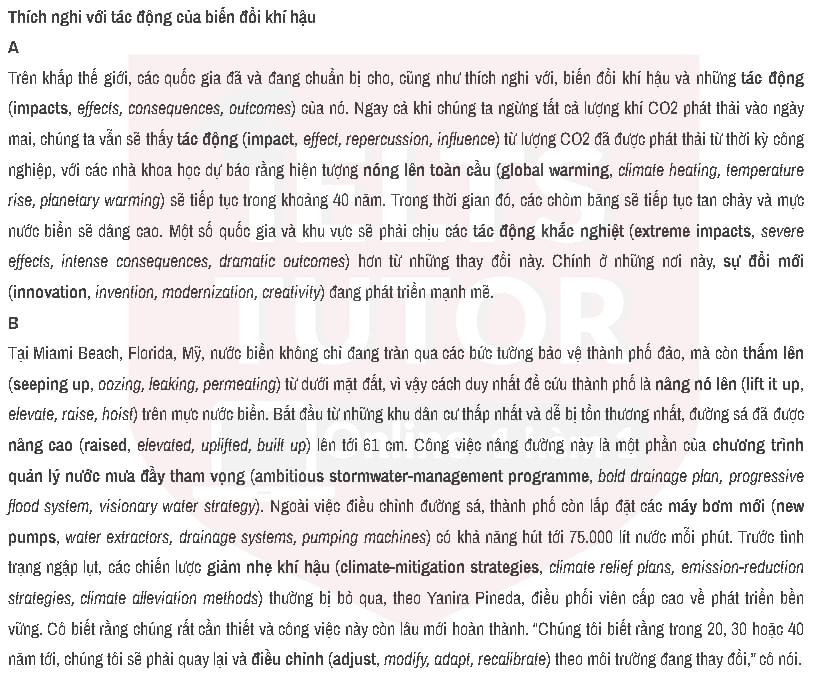
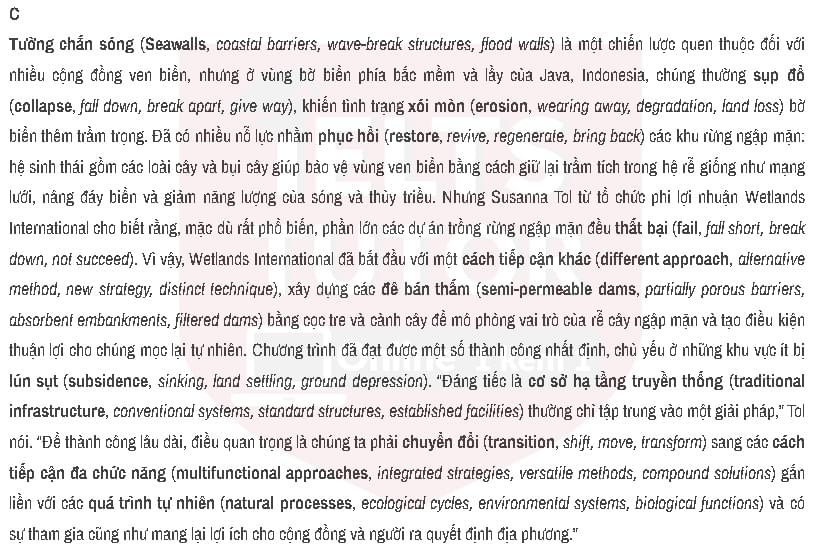
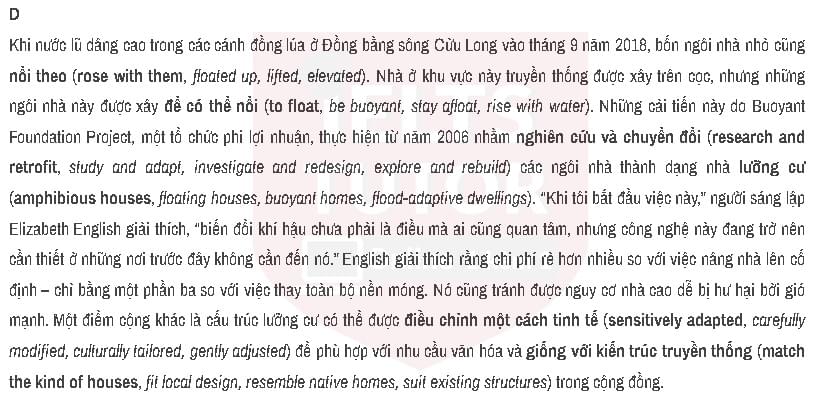
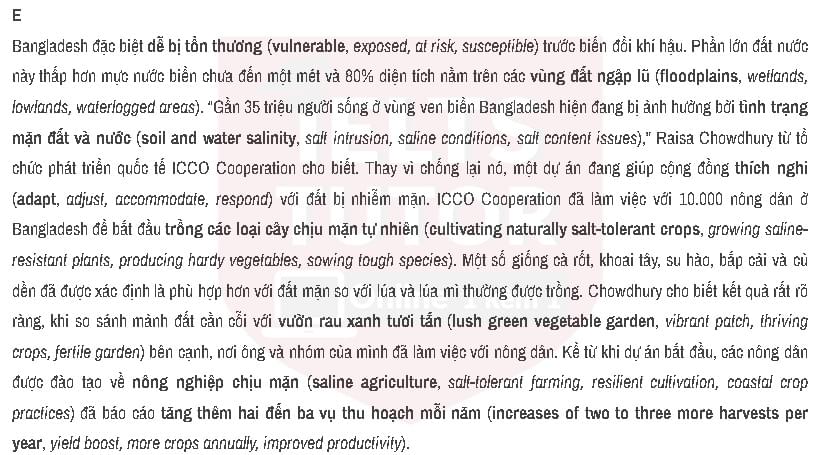
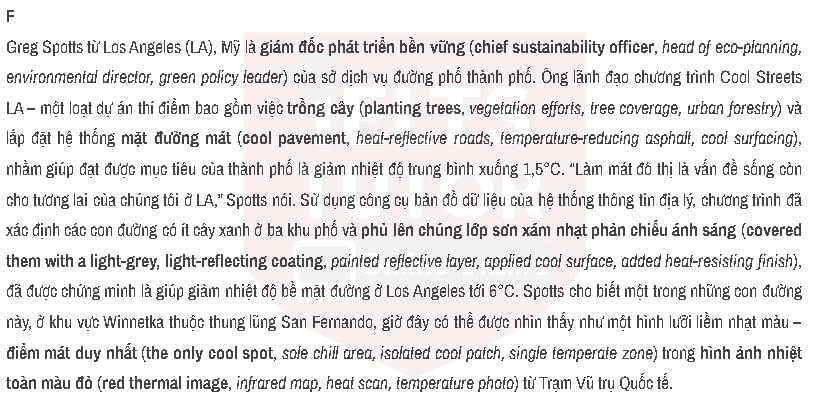
V. Giải thích từ vựng Adapting to the effects of climate change: Đề thi IELTS READING (IELTS Reading Practice Test)- Làm bài online format computer-based, kèm đáp án, dịch & giải thích từ vựng - cấu trúc ngữ pháp khó
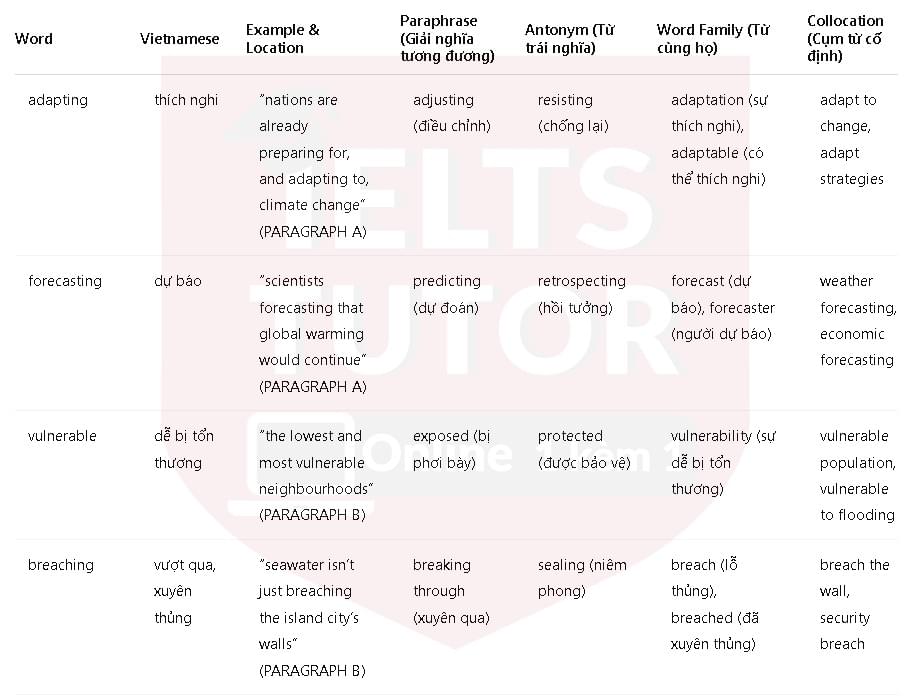
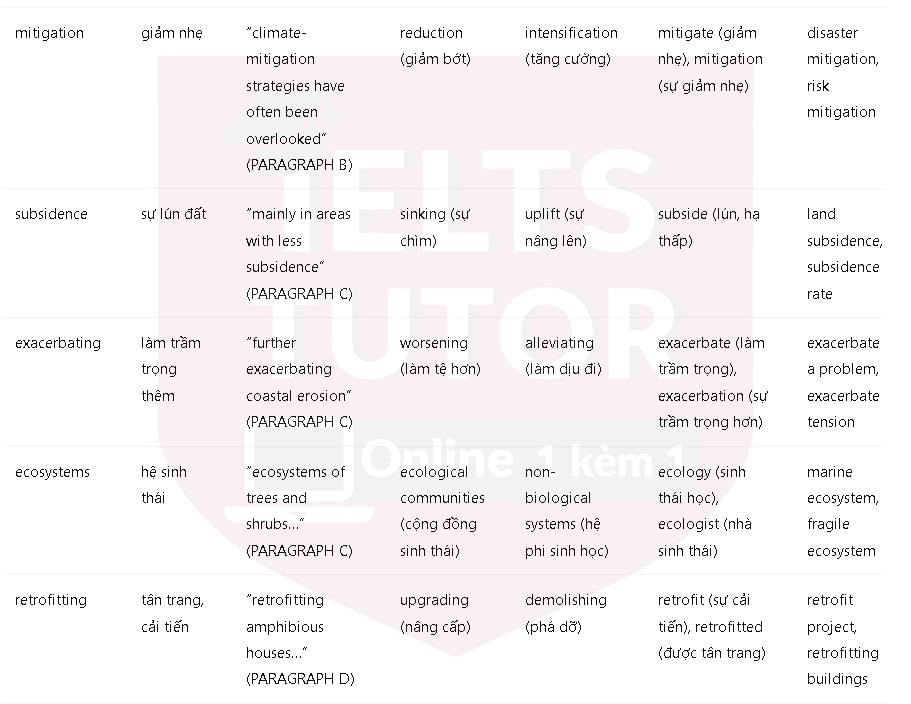
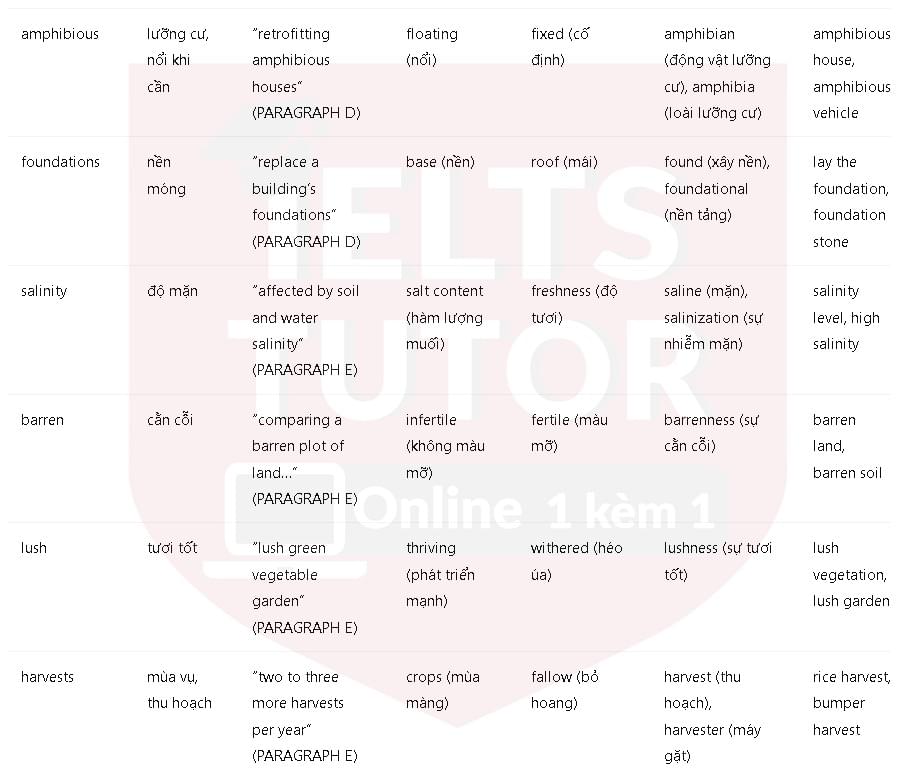
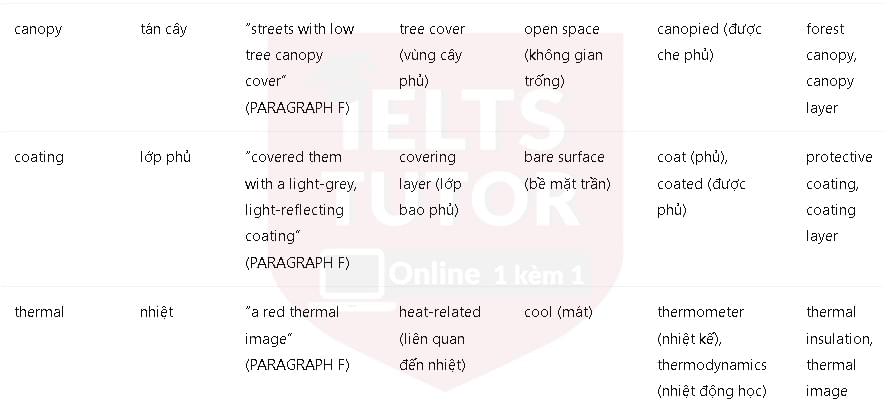
VI. Giải thích cấu trúc ngữ pháp khó Adapting to the effects of climate change: Đề thi IELTS READING (IELTS Reading Practice Test)- Làm bài online format computer-based, kèm đáp án, dịch & giải thích từ vựng - cấu trúc ngữ pháp khó
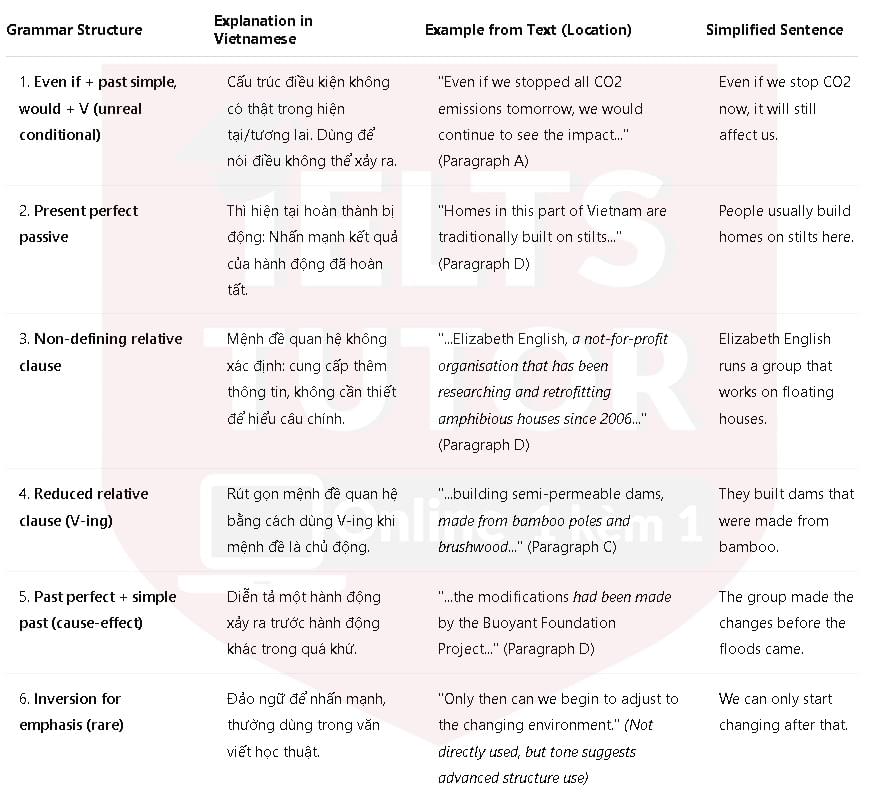
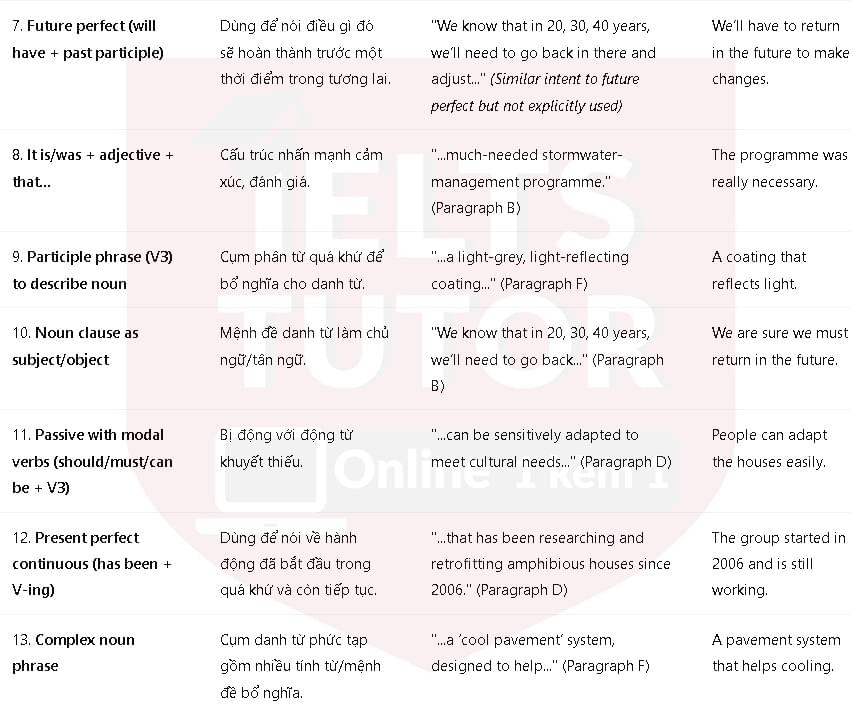
VII. Đáp án Adapting to the effects of climate change: Đề thi IELTS READING (IELTS Reading Practice Test)- Làm bài online format computer-based, kèm đáp án, dịch & giải thích từ vựng - cấu trúc ngữ pháp khó
14. C
15. A
16. D
17. F
18. pumps
19. dams
20. float
21. crops
22. trees
23. B
24. E
25. A
26. C >> IELTS TUTOR lưu ý: PHÂN TÍCH ĐỀ THI 30/5/2020"Some education systems make students focus on certain subjects at the age of 15, while others require students to study a wide range of subjects until they leave school. What are the benefits of each system? Which is better?"IELTS WRITING TASK 2 (kèm bài sửa HS đạt 6.5)
📩 MN AI CHƯA CÓ ĐÁP ÁN FORECAST QUÝ MỚI PART 1-2-3 NHẮN ZL 0905834420 IELTS TUTOR GỬI FREE HẾT NHA
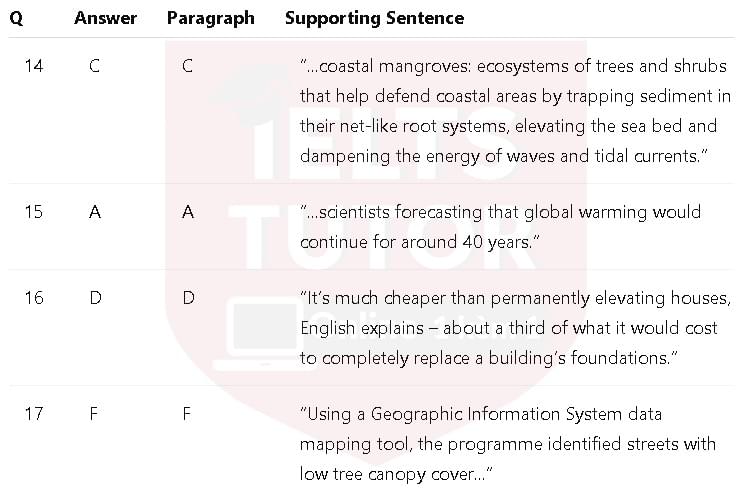
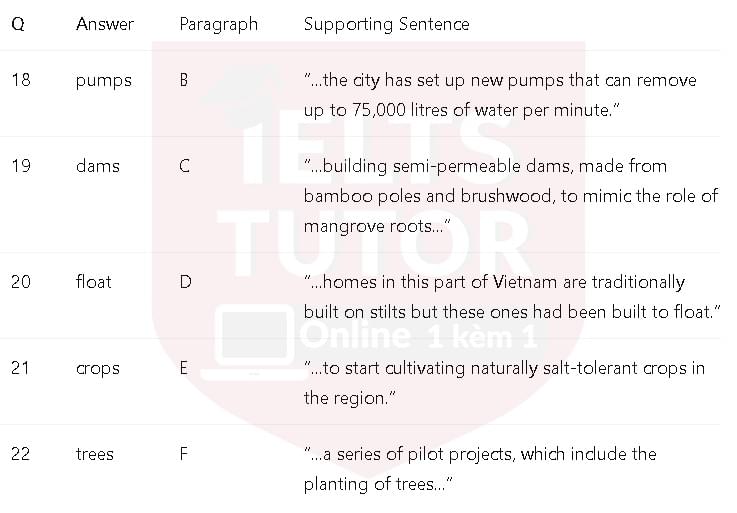
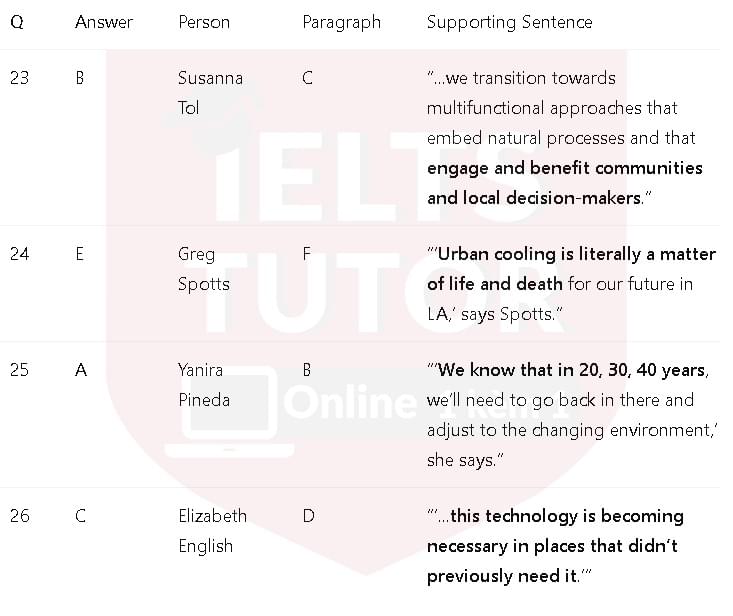
Các khóa học IELTS online 1 kèm 1 - 100% cam kết đạt target 6.0 - 7.0 - 8.0 - Đảm bảo đầu ra - Thi không đạt, học lại FREE



